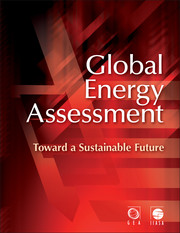Book contents
- Frontmatter
- Contents
- Section 1
- Section 2
- Section 3
- Cluster 1
- Cluster 2
- Cluster 3
- Chapter 17 Energy Pathways for Sustainable Development
- Chapter 18 Urban Energy Systems
- Chapter 19 Energy Access for Development
- Chapter 20 Land and Water: Linkages to Bioenergy
- Chapter 21 Lifestyles, Well-Being and Energy
- Cluster 4
- Section 4
- Index
- References
Chapter 21 - Lifestyles, Well-Being and Energy
Published online by Cambridge University Press: 05 September 2012
- Frontmatter
- Contents
- Section 1
- Section 2
- Section 3
- Cluster 1
- Cluster 2
- Cluster 3
- Chapter 17 Energy Pathways for Sustainable Development
- Chapter 18 Urban Energy Systems
- Chapter 19 Energy Access for Development
- Chapter 20 Land and Water: Linkages to Bioenergy
- Chapter 21 Lifestyles, Well-Being and Energy
- Cluster 4
- Section 4
- Index
- References
Summary
Executive Summary
One of the objectives of the Global Energy Assessment (GEA) is to assess the means through which the potential negative economic, social and environmental impacts from energy use can be mitigated or eliminated, either by increasing the efficiency of energy use or by switching to primary energy sources and carriers. A large set of factors influence ultimate energy use beyond those related to income and affluence. These include non-economic and nontechnological drivers such as behavior, lifestyle, culture, religion and the desire for improved well-being.
This chapter focuses on these underlying drivers and explores how they could influence energy use and choice of energy sources while maintaining desired levels of affluence or income. It reviews the factors that determine how socio-economic indicators of affluence and other non-technological drivers may translate into demand for energy services (for definition of energy services, see Chapter 1) and at the interventions, policies and measures (such as taxes, infrastructure, building codes, and access to information) that could modify or change lifestyles and preferences.
In addition to the consumption of goods and services and their quality, the chapter also focuses on two elements of lifestyle choices that have significant implications for energy use: diet and mobility (household energy use, another key element, is discussed in Chapter 10 while transport is discussed in Chapter 9).
- Type
- Chapter
- Information
- Global Energy AssessmentToward a Sustainable Future, pp. 1527 - 1548Publisher: Cambridge University PressPrint publication year: 2012
References
- 11
- Cited by

